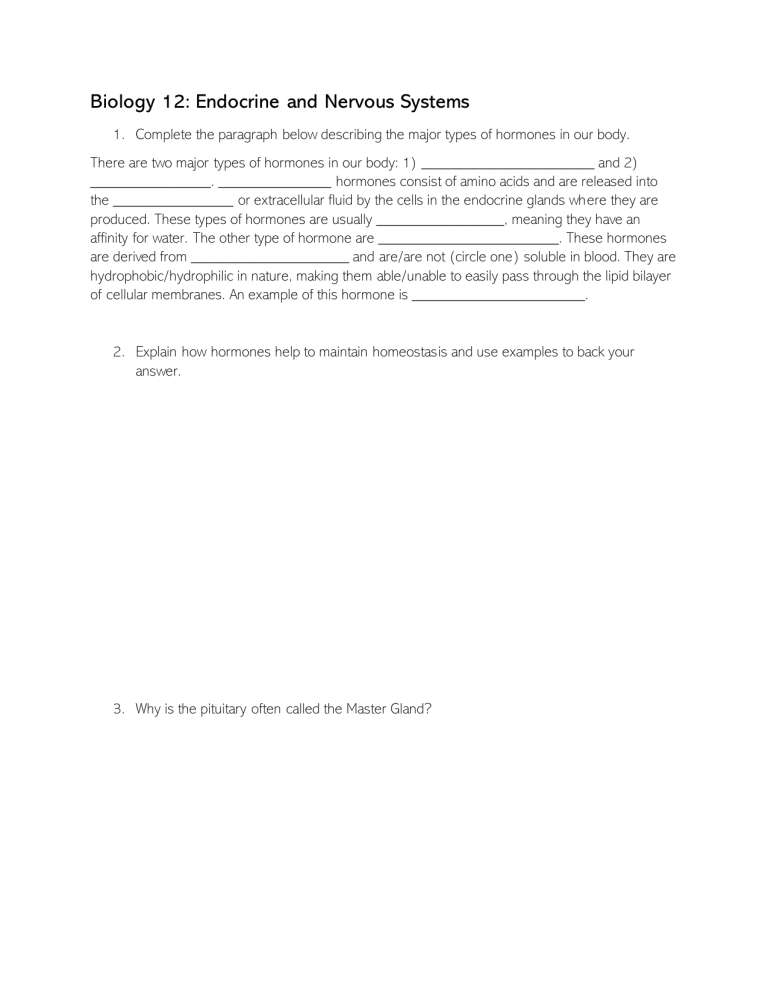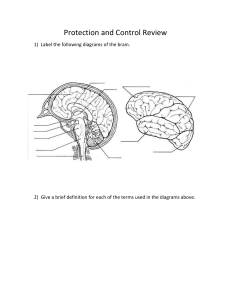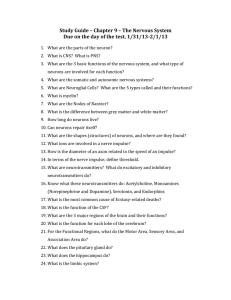
Biology 12: Endocrine and Nervous Systems 1. Complete the paragraph below describing the major types of hormones in our body. There are two major types of hormones in our body: 1) _______________________ and 2) ________________. _______________ hormones consist of amino acids and are released into the ________________ or extracellular fluid by the cells in the endocrine glands where they are produced. These types of hormones are usually _________________, meaning they have an affinity for water. The other type of hormone are ________________________. These hormones are derived from _____________________ and are/are not (circle one) soluble in blood. They are hydrophobic/hydrophilic in nature, making them able/unable to easily pass through the lipid bilayer of cellular membranes. An example of this hormone is _______________________. 2. Explain how hormones help to maintain homeostasis and use examples to back your answer. 3. Why is the pituitary often called the Master Gland? 4. Compare and contrast the pathways for water-soluble hormones and lipid-soluble hormones. 5. How does a steroid hormone differ from a peptide hormone in how it affects target cells? 6. Explain how the structure of a nephron is related to its function. 7. Compare how endocrine messages differ from nervous messages. 8. Fill in the blanks. There are _______ major senses in our body that help us to navigate the world. They are: ___________________________________________________________________ (list all). These senses send neural signals to our brain through ____________ neurons, where the information is processed by __________________. After integration (i.e. neural messages are sorted and interpreted), signals are sent from the brain to effectors through ______________ neurons. This process of sending neural messages from stimulus to brain to effector is called __________ ____________. 9. What does CNS and PNS stand for? What is the major difference between the two? 10. An analogy of a phone charger wire is often made when explaining the anatomy of a neuron. Why is that the case? Explain the anatomy of the neuron (draw a labeled diagram to explain your answer) 11. a) What is the name of this synapse? b) There is another type of synapse. Draw and label it below: c) What are the differences between the synapses in a) and b)? Multiple Choice 1. Which of the following statements is true? a) Neurons fire at a variety of strengths b) Neurons can carry a message indefinitely c) Neurons require no time to recover d) Neurons cannot regenerate their axons e) None of the above are true 2. Which of the following occurs first? a) Neurotransmitters are digested by enzymes b) Synaptic vesicles join with the membrane of the presynaptic neuron c) Neurotransmitters bind to receptors on the postsynaptic membrane d) Neurotransmitters travel across the synaptic cleft e) An impulse begins in the post-synaptic membrane 3. Which is the role of cerebrospinal fluid? a) Cushioning the brain b) Providing nutrients to the brain and spinal cord c) Removing waste products d) Fighting infections e) All of the above 4. Which of the following would be an effect of stimulation by the parasympathetic nervous system? a) Increasing breathing rate. b) Increasing the concentration of glucose in the blood. c) Relaxing the bladder sphincter d) Slowing digestive processes e) Slowing heart rate 5. Which part of the brain connects the nervous and endocrine systems? a) Cerebellum b) Cerebrum c) Corpus callosum d) Hypothalamus e) Pineal body 6. Which of the following statements is true? a) Nerve and neuron are synonymous terms. b) Neurons carry messages in both directions. c) One neuronal cell may run from your big toe to your spinal cord. d) Neurons have no nuclei d) All of the above are true 7. The attempt of the body to reverse changes in its condition is referred to as a) Adaptation b) Homeostasis c) Negative feedback d) All of the above e) b and c only 8. Which of the following is not a part of the peripheral nervous systems? a) Cerebral lobes b) Motor neurons c) Parasympathetic nerves d) Sensory neurons e) Sympathetic nerves 9. Which of the following is not an effect of neurotransmitters? a) They stimulate an impulse in a neuron b) They make it more difficult for an impulse to start in a neuron c) They stop a neuron from passing messages d) They make it easier for an impulse to start in a neuron e) All of the above are possible effects. 10. The light that we detect with our eyes is an example of a) Interneurons sorting and interpreting a neural signal b) Sensing a stimulus and firing up sensory receptors of efferent neurons c) Effectors responding to neural messages from efferent neurons d) Firing up the reflex arc e) Sensing a stimulus and firing up sensory receptors of afferent neurons 11. The role of the medulla oblongata is: a) Connecting the spinal cord to the cerebellum and dealing with autonomic nerve control. b) Connecting the spinal cord to the cerebellum and dealing with muscle movements and balance c) Connecting the brain to the heart, which means its only role is to control heartbeat and blood pressure. d) Connecting the nervous system to endocrine system e) Language formation/learning







